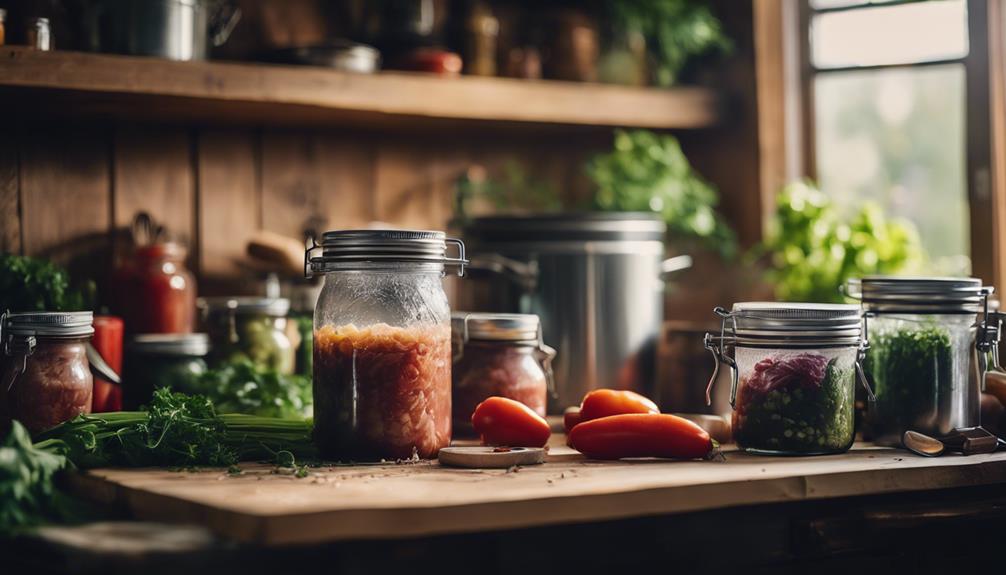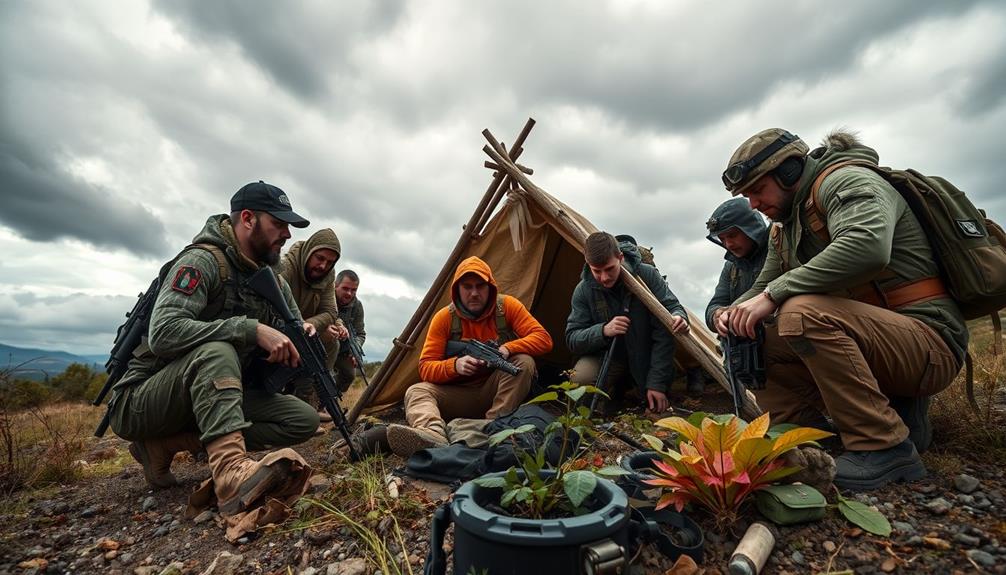Mastering the art of meat pressure canning is crucial for preserving low-acid foods safely. Selecting the right pressure cooker, whether a dial gauge or a weighted jiggler, is essential for accurate processing. This method creates a sealed environment, effectively raising the boiling point of water to eliminate harmful bacteria. Key equipment includes sturdy glass jars, airtight lids, and tools like jar lifters. Preparing jars and meat properly, followed by a precise processing time of 1 hour and 15 minutes for pints, guarantees safety and quality. Explore further for in-depth techniques and tips to perfect your meat canning skills.
Key Takeaways
- Select a suitable pressure canner, choosing between dial gauge or weighted jiggler, ensuring safety for meat pressure canning.
- Always follow established guidelines for processing times and pressures based on meat type and jar size.
- Prepare canning jars by washing, heating, and ensuring both jars and meat are hot before filling for optimal sealing.
- Process pints for 1 hour 15 minutes and quarts for 1 hour 30 minutes at 10 psi for effective preservation.
Choosing the Right Pressure Cooker
Selecting an appropriate pressure cooker is vital for successful meat pressure canning, as the right equipment guarantees ideal safety and efficiency during the canning process.
Various types of pressure cookers are available, including dial gauge and weighted jiggler options. While brand preference may vary among users, affordability should be a key consideration.
Dial gauges require annual testing to verify accuracy, with replacements necessary if deviations exceed 1 psi, while weighted jigglers do not require such testing and should only be replaced if damaged.
It is important to use a pressure canner rather than a boiling water canner for low-acid foods like meat, confirming that the chosen equipment meets the specific requirements of meat pressure canning for best results.
Understanding Pressure Canning
To effectively master meat pressure canning, it is crucial to grasp the fundamental principles and procedures that guarantee safety and quality throughout the process. Preserving peppers at home can also involve pressure canning, and understanding the proper techniques is essential to prevent the growth of harmful bacteria. It is important to follow approved recipes and guidelines to ensure that the peppers are properly processed and sealed in the jars. Additionally, carefully monitoring pressure and processing times is crucial to achieving the desired results and maintaining the safety and quality of the preserved peppers.
Pressure canning is a method specifically designed for low-acid foods, such as meats, which require higher temperatures to eliminate harmful bacteria. This technique utilizes a pressure canner to create a sealed environment that raises the boiling point of water, guaranteeing safe preservation.
Accurate processing times and pressures are critical, as they vary based on the type of meat and jar size. Following established guidelines, including the use of appropriate jars and lids, guarantees a successful canning experience.
Understanding these foundational elements is essential for achieving delicious, shelf-stable meat products.
Essential Canning Equipment

Essential canning equipment includes a pressure canner, jars, lids, and rings, all of which are vital for guaranteeing a safe and effective preservation process.
The pressure canner is essential for processing low-acid foods such as meat, maintaining the necessary temperature and pressure to eliminate harmful bacteria.
Jars, preferably made of glass, should be sturdy and designed specifically for canning, while lids must provide an airtight seal to guarantee food safety.
Rings are used to secure lids during the canning process.
Additionally, consider investing in tools like a jar lifter, jar funnel, and bubble remover to facilitate an efficient and orderly canning experience.
Proper equipment not only enhances safety but also contributes to the overall success of your canning endeavors.
Preparing Your Canning Jars
Proper preparation of canning jars is vital to guarantee food safety and successful preservation during the pressure canning process. Start by washing jars in hot, soapy water to confirm sanitation. Both the jars and the meat should be hot packed, meaning they must be heated prior to filling. Maintain jar heat by using an oven or hot water. Additionally, follow specific instructions for preparing the lids to confirm a proper seal. It is essential to place two inches of water in the canner before loading the jars to guarantee even heating and pressure.
| Step | Description |
|---|---|
| Wash jars | Use hot, soapy water |
| Heat jars | Use oven or hot water |
| Prepare lids | Follow manufacturer's instructions |
| Fill jars | Confirm both jars and meat are hot |
| Add water to canner | Two inches before loading jars |
Step-by-Step Meat Canning Process

With the jars prepared and the necessary equipment in place, the next step involves executing the meat canning process meticulously to guarantee both safety and quality.
Begin by hot packing the jars with pre-cooked, seasoned meat, ensuring that each jar is filled to leave appropriate headspace.
Pour two inches of water into the pressure canner before placing the jars inside.
Secure the canner lid and heat to reach the required pressure of 10 psi.
Process pints for 1 hour 15 minutes and quarts for 1 hour 30 minutes.
Once processing is complete, remove the canner from heat and allow the pressure to drop naturally.
Frequently Asked Questions
Can I Use Frozen Meat for Pressure Canning?
Using frozen meat for pressure canning is not recommended. Thaw the meat fully before canning to guarantee even processing and to reduce the risk of spoilage. Proper preparation is essential for safe and effective canning.
How Long Can Canned Meat Be Stored?
Canned meat can be stored for up to five years, maintaining quality if kept in a cool, dark place. Notably, properly sealed jars can remain safe to eat beyond this period, though taste may diminish over time.
Is It Safe to Can Meat With Bones?
Canning meat with bones is generally safe, provided proper pressure canning techniques are followed. Guarantee that processing times and temperatures are adhered to, as bones can affect heat penetration, potentially compromising safety and quality.
Can I Mix Different Meats in One Jar?
Imagine a culinary symphony where various meats harmonize in one jar. However, it is essential to highlight that mixing different meats in a single jar is not recommended due to varying processing times and safety concerns.
What Should I Do if a Jar Doesn't Seal?
If a jar doesn't seal, inspect the lid for damage, clean the rim, and reprocess within 24 hours. Alternatively, refrigerate the contents and consume within a few days to guarantee safety and quality.
Conclusion
In summary, mastering the art of meat pressure canning not only preserves the nutritional integrity and flavor of food but also empowers individuals to take control of their culinary experiences.
As the adage goes, “An ounce of prevention is worth a pound of cure”; meticulous attention to detail in the canning process guarantees food safety and quality.
Embracing this skill transforms the kitchen into a sanctuary of sustenance, where the fruits of labor can be savored long after the harvest.










